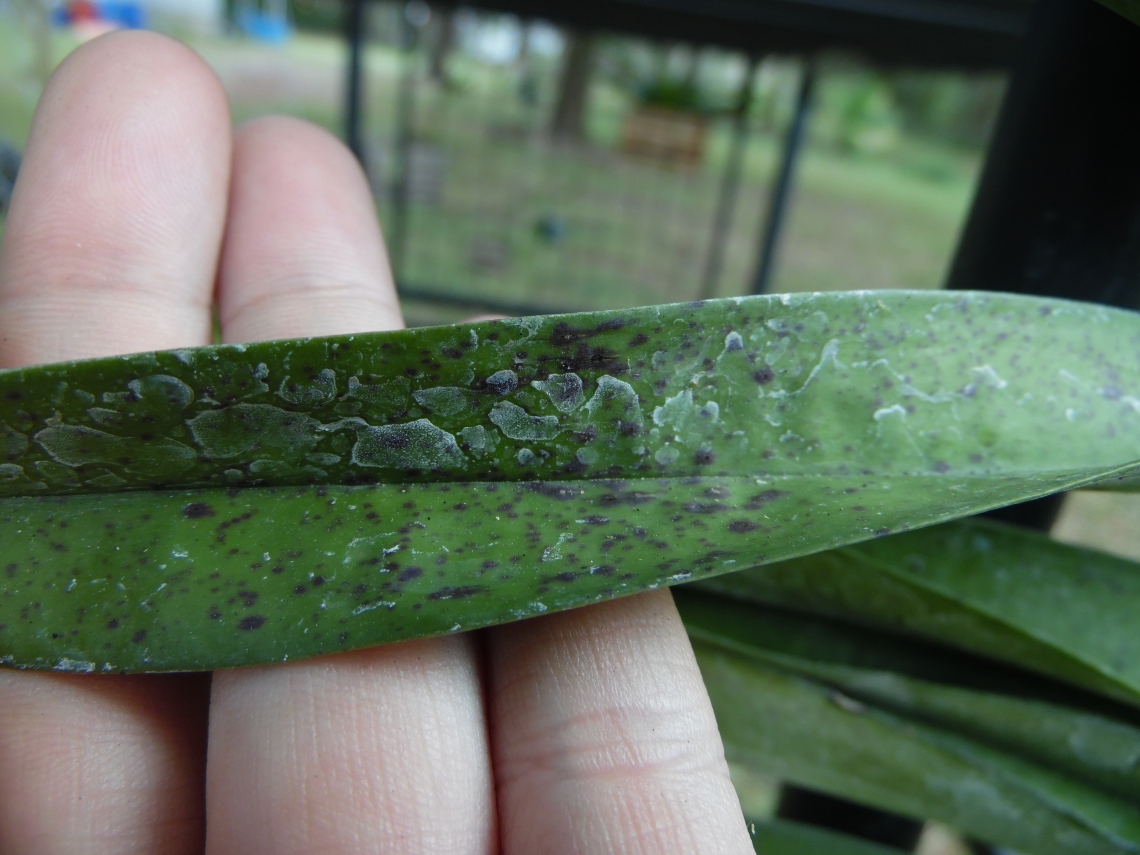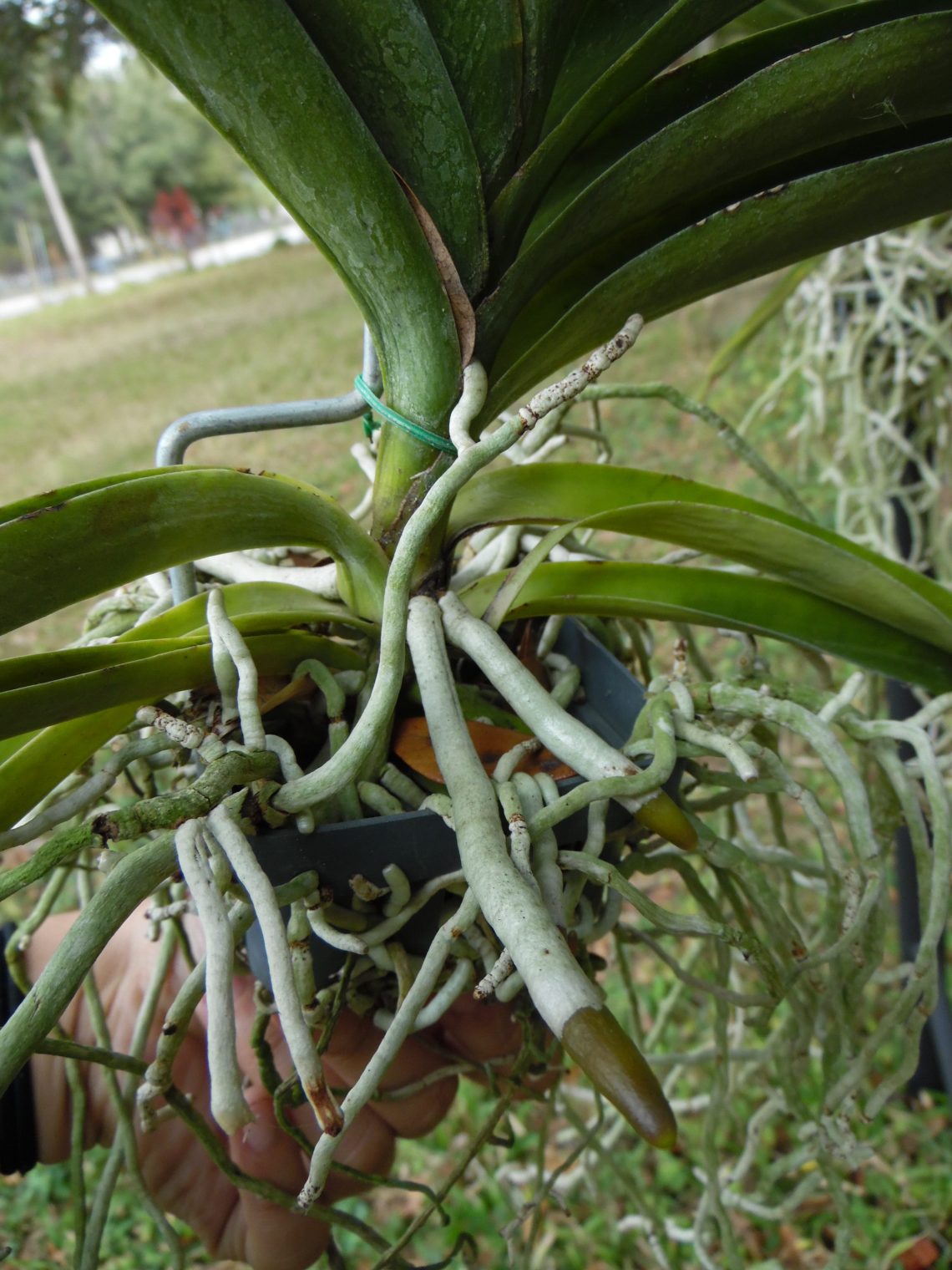Being half-Filipino and taking occasional balikbayan trips, it would be impossible for me to deny the Filipino cultural obsession with orchids. Vandas in particular are an object of extreme obsession for a lot of people, not just Filipinos, and it’s not difficult to understand why: These plants dangle gracefully, usually totally devoid of a growing medium, with their vellum-wrapped roots swaying wistfully beneath them. They appear incredibly delicate and frail, but the reality is that waving your roots around is a tough way to go about surviving. Vandas are not the only plants that can do this, but they are certainly flashy about it and are much better evolved to survive in such conditions.
For the typically-available vandas that can be purchased at hardware stores or local nurseries, usually at about $25-40 per large plant and $7-12 for much smaller starter plants, there is no need to be intimidated by these beauties. This care sheet applies to zones 8-10.
Here is a quick care-card for the Rapunzels of the orchid world:
- High humidity and high light
- Only use of RO or distilled water
- Do. Not. Over. Water. (And of course do not allow to desiccate)
- Fertilize only with weakest concentration of fertilizer, sparingly and only on roots.
In order to save yourself from having to spritz these babies night and day, you will want to place them in an area that has a naturally higher humidity. For me, this happens to be hanging outside near a ditch on my property. The humidity level out there ranges from 80-95 according to my cheap humidity meter. It gets good airflow, but it is also nice and swampy. Greenhouses are of course another good way to hold humidity near your plants.
I say forget about indoors, with some sort of air conditioning or heat running at any given time, because chances are that it will be a very dry and unpleasant experience for this plant. Unless you are willing to dedicate space for hanging plant greenhouse or terrarium, outside / greenhouse is usually better.
High light may not sound right, but vandas love light. In the Philippines it is common to see varieties like this tied to stumps with no shade at all. That’s right, they can grow in full sun and seem to really love it, considering all of the amazing shows of multiple flower spikes, per plant, that I have seen on full-sun vandas. Of course, these were spritzed night and day, but the point is that they would like as much sun as they can get. Please do not immediately go and put your plant right out under the blazing sun, especially if they’ve been shade-grown so far. Rather, try acclimating the plants to a place where they can get maximum light while still staying hydrated and unburned.
Only using RO (reverse osmosis), rainwater, or distilled water on your orchids is very very important. If you don’t use this highly purified water, where all of the dissolved solids and minerals have been removed from solution, you get buildup on your plants that looks like this (I have a well and it’s awful for many of my plants)

As you can see, this buildup is so crappy. It is not helping my plants in anyway, and in fact helps contribute to growth of fungi, bacteria, and other nasty crap by giving it a foothold to stick onto the leaves. I’m guilty of using well water on my poor plants, but if you are experiencing plants getting sick and yucky, you might try to soak or mist with RO water and see if that solves your problems.
DO. NOT. OVER. WATER. Your mileage will definitely vary, but as an example I may only soak my vandas a couple times a week, if that, in the heat and rain of the Zone 9b summer. And during winter, twice a week at the most. Vandas are epiphytic, in much the same way airplants like Tillandsia are, which means that they are particularly talented at grabbing and retaining water when they can get it and surviving without it when they can’t. The very function of the vellum (whitish silvery sheath) covering orchid roots is to rapidly absorb water whenever they are exposed to it. This also means that if you you over saturate them constantly, they will be prone to fungi or bacterial growth and will begin to turn yellow and rot.

When you must water, observe the vellum. It will slowly turn from opaque white, with some spots turning light green until the entire root is green. That is how you know the root is saturated and does not need further watering. People have success with both misting them until the roots turn this color, or from simply dunking the plant up to the base of the leaves in a bucket of water.
Fertilizer? I really don’t think vandas need it unless you wish to enter them in a show. I fertilize very sparingly because, well I have hard water! Using typical orchid fertilizer, dilute it to half of the manufacturers specifications, and only apply this water to the roots of the plant (to prevent nasty buildup on the leaves). Fertilizer helps support the formation of beautiful big blooms. These flowers came out to be about 2.5 inches wide… Unbelievable.
When it comes to a growing medium, well as you can see I don’t really use one. For my plants it just appears to help harbor infections and nasties. If you have trouble keeping your plants moist or if they just seem unstable and not happy with their container, I would give bark chips with charcoal chunks a try as well. I have seen people with vandas potted in dirt that were doing unbelievably amazing ( I was agape). In my bosses garden I mounted one on a piece of broken mangrove root that is doing amazingly, and she never ever touches it during the week when I’m not there (I don’t touch it either!) . I guess it’s all about experimenting with what works best for your habits and habitat.
And overall, that is the basic care of vanda orchids. True fanciers of these botanical Rapunzels may scoff, but the reality is that most of the commonly available vandas do not always need to be babied nor do they need very much special care! We all deserve beautiful curtains of graceful, fascinating roots and spikes of colorful, exotic flowers!





